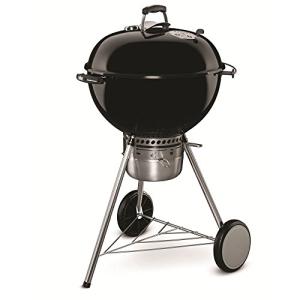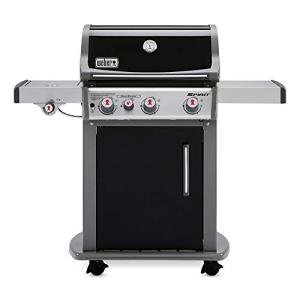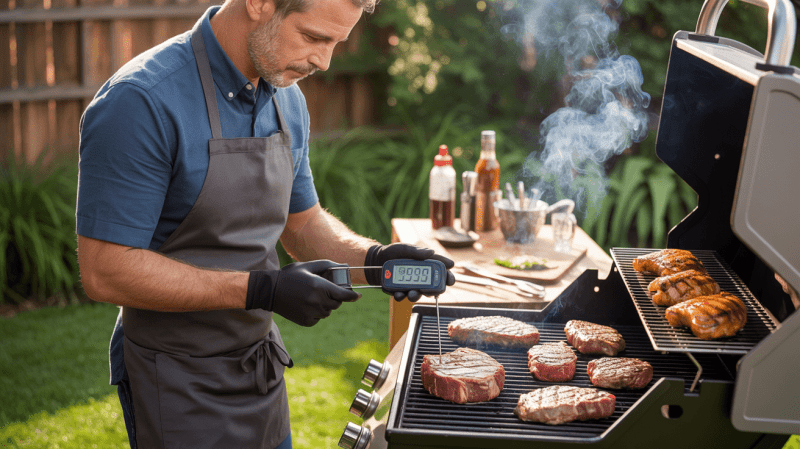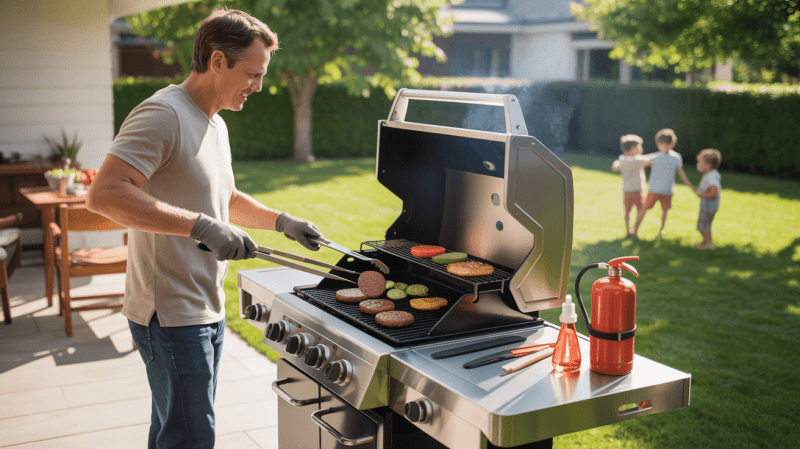Grilling the perfect strip steak can elevate any gathering. It impresses family and friends with its rich flavor and tender texture.
To achieve this, you need to select high-quality New York strip steaks. Then, you must master the grilling technique that brings out their best characteristics.
A well-cooked NY strip satisfies the taste buds and showcases grilling skills.

Preparation plays a key role in ensuring the steak is flavorful and juicy when it comes off the grill. Seasoning the meat simply enhances its natural flavors. Meanwhile, proper grilling techniques help to achieve that ideal crust on the outside and tenderness on the inside.
Understanding the right cooking times and temperatures will guide anyone toward steak perfection.
With the right approach, anyone can enjoy delicious grilled New York strip steaks at home. From choosing the cut to serving it at the table, every step is crucial for a successful grilling experience.
Key Takeaways
- Select high-quality New York strip steaks for the best flavor.
- Proper seasoning and preparation are key for juicy results.
- Mastering grilling techniques ensures perfect cooking and serving.
Choosing the Perfect Cut
Selecting the right cut of steak is essential for grilling success. Different cuts offer varied flavors and textures. Understanding these differences will help you choose what best suits your grilling experience.
Understanding Steak Cuts
Steaks come from different parts of the cow, and each cut has unique characteristics. Common options include:
- New York Strip: Known for its tenderness and rich flavor.
- Sirloin: A leaner cut with slightly less marbling.
- T-Bone and Porterhouse: These versatile cuts include both tenderloin and strip. The main difference is the size of the tenderloin in each cut.
- Filet Mignon: The most tender cut, but has less flavor than others.
Recognizing where each cut comes from can guide one to the best choice based on preferred taste and texture.
Benefits of New York Strip
The New York strip is a popular choice for many grilling enthusiasts. This cut is well-balanced in terms of tenderness and flavor.
- Flavor: It has a robust beefy taste. The richness of flavor makes it stand out.
- Marbling: With good fat distribution, it remains juicy when cooked. This marbling contributes to both flavor and tenderness.
- Cooking Versatility: Able to be grilled on high heat while still remaining tender makes it suitable for a variety of grilling setups.
For those seeking a satisfying steak experience, the New York strip is often a reliable option.
Marbling and Meat Quality
Marbling refers to the small flecks of fat within the steak's muscle tissue. This fat plays a crucial role in the quality of the meat.
- Juiciness: Marbled steaks tend to be juicier because the fat melts during cooking, enhancing moisture.
- Flavor: Increased marbling contributes to a richer flavor profile.
- Quality Grades: The USDA provides grades like Prime, Choice, and Select based on the amount and distribution of marbling. Prime steaks have the best marbling and are often the most expensive.
Choosing cuts with good marbling can greatly impact the grilling outcome. For the best results, look for steaks that showcase this feature.
Preparation and Seasoning

Proper seasoning and meat prep are essential for achieving the best flavor and texture in grilled strip steaks. This ensures that the steaks will be tasty and juicy when cooked.
Seasoning Your Steak
Seasoning is key to enhancing the steak's natural flavor. A simple mixture of salt and black pepper works well. Use coarse sea salt for better distribution and flavor.
-
Apply Salt: Generously sprinkle salt on both sides of the steak. Aim for about 1 teaspoon per side. This helps draw moisture out and brings out the steak's juices.
-
Add Black Pepper: After the salt, add freshly cracked black pepper. Use the same amount as salt or adjust based on preference. The pepper adds a nice bite to the flavor.
-
Rest the Steak: After seasoning, let the steak rest at room temperature for about 30 minutes. This allows the flavors to penetrate the meat better and helps it cook more evenly.
Pre-grilling Meat Prep
Before grilling, proper prep ensures a delicious outcome. Here are steps to prepare the steak:
-
Trim Excess Fat: Trim the fat cap to about 1/4 inch. This helps avoid flare-ups and keeps the steak from becoming too greasy.
-
Pat Dry: Use paper towels to pat the steak dry. Removing excess moisture allows for a better sear.
-
Temperature Check: Let the steak reach room temperature. This can take about 30 minutes and helps it cook evenly. A cold steak can lead to uneven cooking.
The seasoning and preparation will set up the steak for a successful grilling experience by following these steps.
Mastering the Grill

Understanding different grilling techniques is essential to achieving the perfect grilled strip steak. This section explains key concepts in grilling, including heat sources and tips for charcoal and gas grills.
Grilling Techniques
Grilling strip steaks requires knowing the right techniques. Two main methods are direct and indirect heat.
Direct heat grilling is best for searing the steak quickly, creating a flavorful crust. Place the steak directly over the flame for a short time.
Indirect heat is perfect for thicker cuts. It allows cooking through without burning the outside. This method involves placing the steak away from the flame and closing the grill lid.
An instant-read thermometer is invaluable for checking doneness. Aim for 130°F for medium-rare and adjust based on preference.
Direct vs Indirect Heat
Understanding when to use direct or indirect heat is vital.
Direct heat cooks steaks quickly. It's best for a fine crust. Preheat the grill to high heat for this method.
Indirect heat takes longer but is gentler. This method prevents charring. Set up the grill by turning on one side while leaving the other off.
Both techniques are essential for different steak thicknesses. Use direct heat for thinner cuts and reserve indirect heat for thicker steaks that need more cooking time.
Using a Charcoal Grill
A charcoal grill offers unique flavor profiles. Start by lighting the charcoal, allowing it to burn until covered in white ash. This usually takes about 15-20 minutes.
Arrange the hot coals to create a two-zone fire. One side should have high heat for searing, while the other can maintain lower temperatures.
Once the grill reaches the desired temperature, place the strip steak on the hot side. Sear for about 4-5 minutes on each side for medium-rare.
Remember to adjust cooking time based on steak thickness. An instant-read thermometer helps ensure the steak reaches the right internal temperature.
Weber Master-Touch 22-Inch Charcoal Grill, Black
Experience the classic smoky flavor and perfect grill marks with this iconic charcoal grill
Product information
$298.80 $275.00
Product Review Score
4.47 out of 5 stars
32 reviewsProduct links
Using a Gas Grill
A gas grill provides convenience and control. Light the grill and preheat it on high for about 10-15 minutes.
For perfect results, create two heat zones: high heat for searing and lower for finishing.
Place the strip steak on the high heat side first. Sear for 4-5 minutes, then move it to the cooler side if needed.
Monitor the internal temperature closely with an instant-read thermometer. Aim for around 130°F for medium-rare.
Gas grills make it easy to control heat, ensuring even cooking for superb steak.
Weber Spirit E330 Black LP Gas Grill
Get ready to fire up your backyard BBQ with this reliable gas grill that brings delicious flavor to every meal
Product information
$874.80 $729.00
Product Review Score
4.44 out of 5 stars
50 reviewsProduct links
Cooking and Serving

Grilling strip steaks requires attention to the cooking process and how to serve them for the best experience. The following guidelines help achieve the desired doneness and ensure tasty pairings.
Achieving Desired Doneness
Knowing the cooking time for each level of doneness is crucial to grilling strip steaks perfectly. For medium-rare, aim for an internal temperature of 130-135°F. This typically takes about 4-5 minutes per side on a hot grill.
The target for medium is 140-145°F, requiring about 5-6 minutes per side. Medium-well steaks should reach 150-155°F, which may take 6-7 minutes per side. Well-done steaks are cooked to 160°F and above, taking around 7-8 minutes per side.
Using an instant-read thermometer is the best way to check doneness. Remember to remove the steak from the grill a few degrees before the target temperature, as it will continue cooking while resting.
Resting and Serving Steak
Resting the steak after grilling is essential for juicy results. Allow the steak to rest for about 5-10 minutes on a cutting board, loosely covered with foil. This helps redistribute the juices, making every bite tender and flavorful.
When serving, slice the steak against the grain. This makes the meat easier to chew and enhances the eating experience. Steaks can be served whole or sliced into strips for easier sharing.
Temperature variation can affect plating, so consider warming the plates before serving. This helps keep the steak warm longer.
Suggested Pairings
Pairing grilled strip steak with complementary sides is beneficial for a well-rounded meal.
A fresh pasta salad with vegetables and a light dressing makes a great companion. Its acidity balances the richness of the steak.
Other excellent pairings include grilled vegetables, baked potatoes, or a simple mixed greens salad.
These options add texture and flavor without overwhelming the main dish.
Sauces like chimichurri or a classic steak sauce can also enhance the flavor. Choose according to personal preference to elevate the meal experience further.
Frequently Asked Questions

Grilling New York strip steaks involves specific techniques and temperatures for the best results. Here are some common questions that can help improve the grilling experience.
What is the recommended grilling time for a 1-inch thick New York strip steak?
For a 1-inch thick New York strip steak, the grilling time is typically around 8 to 10 minutes.
This includes 4 to 5 minutes per side over medium-high heat.
At what temperature should a 2-inch New York strip steak be grilled?
A 2-inch New York strip steak should be grilled at medium-high heat, around 400 to 450 degrees Fahrenheit.
This allows for a good sear while ensuring the inside cooks properly.
How long should a New York strip steak be grilled to achieve medium-rare doneness?
To achieve medium-rare doneness, the internal temperature of the steak should reach 130 to 135 degrees Fahrenheit.
This usually takes about 4 to 5 minutes per side, depending on the heat of the grill.
How do you grill a New York strip steak on a charcoal grill?
First, light the charcoal and wait until it turns white and is covered in ash.
Then, place the steaks on the grill over direct heat and sear for about 3 to 4 minutes per side.
After that, adjust the heat to ensure even cooking and consider moving the steak to indirect heat if necessary.
How can you cook a New York strip steak on a stovetop?
Heat a skillet over medium-high heat to cook a New York strip steak on a stovetop.
Then, add oil and place the steak in the pan. Cook for 4 to 5 minutes on each side for medium-rare, adjusting the time for desired doneness.
How often should you flip a steak when grilling to ensure even cooking?
It is best to flip a steak only once during the cooking process. This helps create a nice crust. It also allows the heat to penetrate evenly throughout the meat.
DISCLAIMER
This document is provided for general information purposes only. It should not be relied upon as providing legal advice, technical, or specific operational guidance to the reader, whether as to the practices described in the document or the applicable legal requirements and regulations. Backyard Grilling Pros.com expressly disclaims any responsibility for liability arising from or related to the use or misuse of any information in this document.
DISCLAIMER
This document is provided for general information purposes only and should not be relied upon as providing legal advice, technical, or specific operational guidance to the reader, whether as to the practices described in the document or the applicable legal requirements and regulations. backyardgrillingpros.com expressly disclaims any responsibility for liability arising from or related to the use or misuse of any information in this document.




